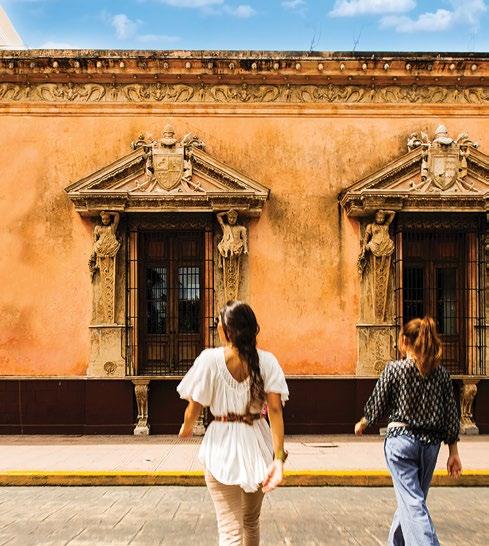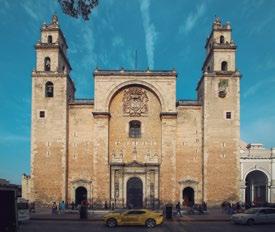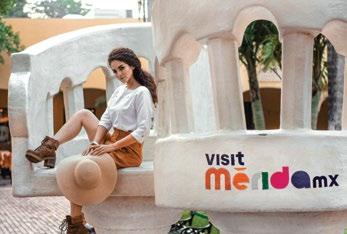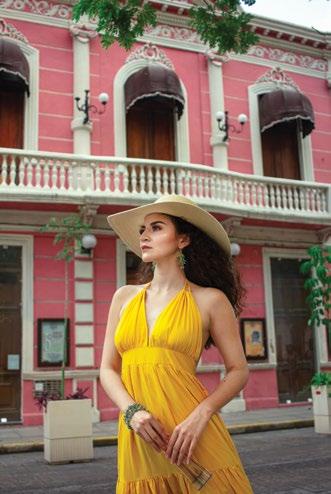
3 minute read
Portada | Cover
FOTO EN PORTADA PEDRO HERNÁNDEZ MODELO REBECA GARCÍA SOSA MUA: JANET ROMERO
LA CIUDAD CELEBRA 479 AÑOS
Advertisement
Hemos llegado al último mes del 2020, un año completamente atípico por la contingencia. En estos momentos estaríamos realizando los preparativos de la cena familiar navideña y de pasar un momento agradable con los amigos para despedir al año y darle la bienvenida al 2021. No bajemos los brazos y no nos confiemos, cumplamos con todas las medidas sanitarias recomendadas por las autoridades de salud. Mientras tanto, agradecemos tu preferencia por leernos cada mes y te deseamos una feliz navidad y próspero año nuevo, que el 2021 sea un año de muchos cambios positivos en tu vida.
We have reached the last month of 2020, a completely abnormal year due to global pandemic to be sure. This is the time of year, however, when we would be making preparations for the family Christmas dinner and spending a pleasant moment with friends to bid this year goodbye and look forward to welcoming 2021. Let’s not lower our guards, however, and become overconfident! We must comply with all the sanitary recommendations health authorities make. In the meantime, we appreciate your preference in reading our magazine each month. We wish you a Merry Christmas and a Happy New Year. May 2021 be a year of many positive changes in your life.
En esta ocasión, hemos preparado una portada especial porque el próximo mes de enero de 2021, Mérida cumplirá un año más de “vida”, para ser más exactos 479 años, ya que un 6 de enero de 1542 la ciudad fue fundada por Francisco de Montejo “El Mozo” en los antiguos asentamientos y vestigios mayas de la antigua ciudad maya Ichcaanzihó (cinco cerros) o también conocida como T´Hó. Tras la llegada de los españoles y fundación de Mérida en la antigua provincia de Chakán que estaba abandonada y que no contaba con un líder a mediados del siglo XVI, comenzaría un proceso de crecimiento y urbanización. ¿Sabes cómo era dicha urbe maya antes de que diera nacimiento a Mérida y cómo la conoces en estos días?

Antes de su fundación, la futura capital yucateca pasó por varias etapas. Al despejar los terrenos llenos de maleza que cubrían construcciones mayas, observaron las plazas donde acudían los mayas únicamente en fechas o en celebraciones especial, debido a que no tenían una función recreativa, sino ceremonial.
Cuando los colonizadores estaban trazando y construyendo la ciudad, lo hicieron siguiendo el modelo urbano que conocían. El primer trazo de Mérida se realizó en un principio en forma teórica, ya que la nueva urbe carecía de instalaciones elementales. Los nuevos pobladores españoles vivían en casas de paja que les pertenecieron a los mayas.

EDITORIAL COMPLETA EN WWW.EXPLORE.MX

CONGRATULATIONS MERIDA!
THE CITY CELEBRATES 479 YEARS

For this issue, we have prepared a special cover because come January 2021, Mérida will turn one more year of “life” as a city: On January 6, 1542 the city, founded by Francisco de Montejo “El Mozo” upon the ruins of the abandoned Maya ceremonial center known as Ichcaanzihó (“Five Hills”) or T´Hó, turns 479 years old! After the arrival of the Spanish and the founding of Mérida in the old province of Chakán, which had been long abandoned by the middle of the 16th century and had no residents, a process of growth and urbanization began. Do you know what this Maya ceremonial was like before Mérida was founded and how we know it for the city it is today? Before its founding, the future capital of Yucatán State went through several stages. When clearing the overgrown grounds that covered Maya constructions, the first Spanish and Africans witnessed the Maya only visited the place on specific dates or for special celebrations. The ruins only had a ceremonial role in

the lives of nearby communities.
When the Spanish mapped out and built the city, they did so following the urban model they knew based on cities in Spain. The first streets of Mérida were initially laid out consistent with European grid systems, but the new city lacked basic facilities. The new Spanish settlers lived in thatch-roof structures similar to the ones the Maya used.




